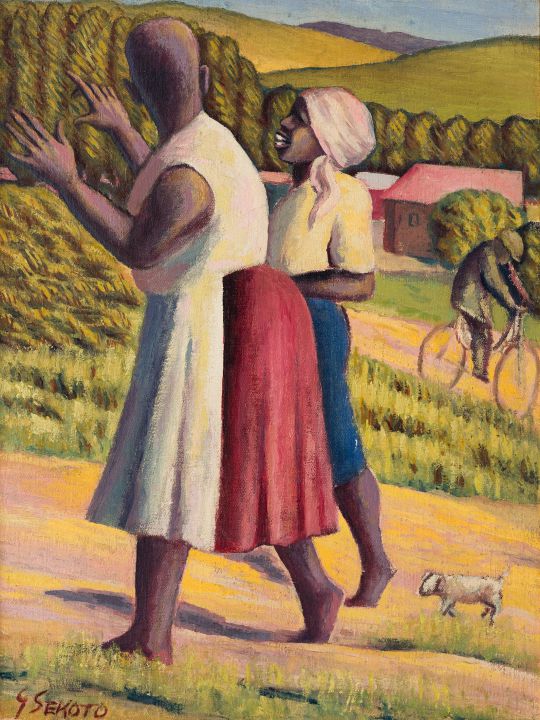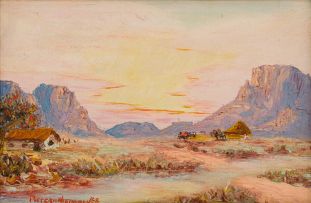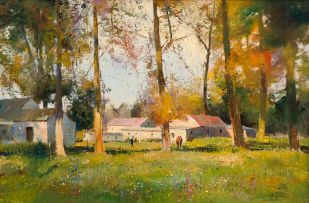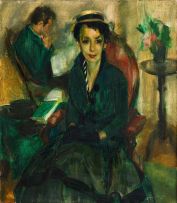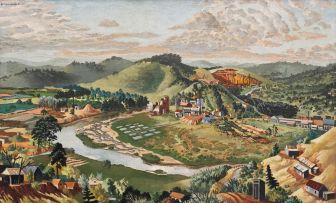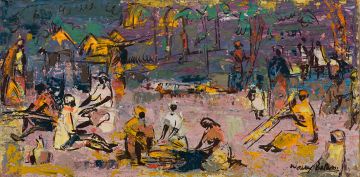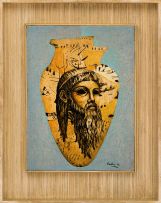Women in the Country
Gerard Sekoto
Incl. Buyer's Premium & VAT
About this Item
signed
Notes
In 1945, following a lengthy stay in Cape Town, Gerard Sekoto moved to Eastwood, a run-down black settlement outside Pretoria, to live with his mother and stepfather. Sekoto knew he wanted to move to Paris, but viewed his relocation upcountry as a necessary prelude: "Before leaving, however, I wanted to dig into my ancestral roots, as I no longer believed that the tradition of my forefathers was evil."1 However, unable to visit the village of his Pedi forebears Sekoto turned to his immediate environment. Already attuned to describing aspects of black urban life from his extended sojourns in Sophiatown and District Six, Sekoto went on to produce gregarious studies of domesticity and street life marked by their formal innovation and painterly maturity.
It is widely acknowledged that the paintings Sekoto produced in the two-year period between his arrival in Eastwood and his departure for France in 1947 represent the highpoint of his artistic career. Acknowledged masterpieces like Sixpence a Door (1946) and Song of the Pick (1946) date from this keynote period. Writing in the catalogue that accompanied Sekoto's first major retrospective exhibition, held at the Johannesburg Art Gallery in 1989, curator Lesley Spiro notes: "It was a time when he pushed his understanding of colour and form to new heights, when he seemed to sharpen even further his already remarkable sense of mood and movement."2
Women in the Country (lot 327) is a product of this fertile period and was included on Spiro's landmark 1989 exhibition. She identified the painting as bearing many of the hallmarks of Sekoto's Eastwood period, notably "the graphic treatment of the landscape, the oil-slick-like shadows, and the solid, three-dimensional drapery".3 The painting also reveals how Sekoto looked and positioned himself relative to his subjects. Sekoto's biographer N Chabani Manganyi writes that the artist possessed a "precocious inquisitiveness and wonder".4 This is certainly clear here. Sekoto was an unobtrusive observer, adept at standing to one side and - like a documentary photographer - recording the way people commuted, dressed, mingled, toiled and laughed, without judgement. Oftentimes his subjects don't seem to even register his presence.
The Pink Road (lot 328) is an earlier example of Sekoto's understated way of witnessing. The work was painted during Sekoto's Sophiatown period (1939-42), when he became associated with Johannesburg art dealer Joan Ginsberg of the Gainsborough Galleries, found admiring patrons for his work, and also became acquainted with contemporaries like Alexis Preller and Walter Battiss. The work was exhibited at the Grand Hotel in Salisbury, Rhodesia (now Harare, Zimbabwe), in July 1943 on an exhibition of paintings by Maud Sumner, together with English and South African artists selected by the Gainsborough Galleries. Spiro notes that Sekoto's contribution to the exhibition was singled out for attention in four contemporary newspaper reports. Although attention waned after his move to Paris, Sekoto is now celebrated as a pioneering modernist painter and participant in the formation of a progressive and authentic canon of South African painting.
1 N. Chabani Manganyi, Gerard Sekoto: "I am an African", Johannesburg: Wits University Press, 2004, p.43
2 Lesley Spiro, Gerard Sekoto: Unsevered Ties, Johannesburg: Johannesburg Art, 1989, p.41
3 Ibid., p.39
4 Manganyi, op.cit., p.45
5 Spiro, op.cit., p.31
Exhibited
Johannesburg Art Gallery, Johannesburg, Gerard Sekoto: Unsevered Ties, 1 November 1989 - 10 February 1990, catalogue number 62.
Cité Internationale des Arts, Paris, in association with Iziko South African National Gallery, Cape Town, A Portrait of South Africa: George Hallett, Peter Clarke and Gerard Sekoto, 30 October 2013 - 27 November 2013.
Literature
Lesley Spiro (ed.) (1989). Gerard Sekoto: Unsevered Ties, Johannesburg: Johannesburg Art Gallery. Illustrated in colour on page 83.
Barbara Lindop and Chloë Reid (eds.) (2013). Song for Sekoto: Gerard Sekoto 1913-2013, Johannesburg: The Gerard Sekoto Foundation. Illustrated in colour on page 101.
